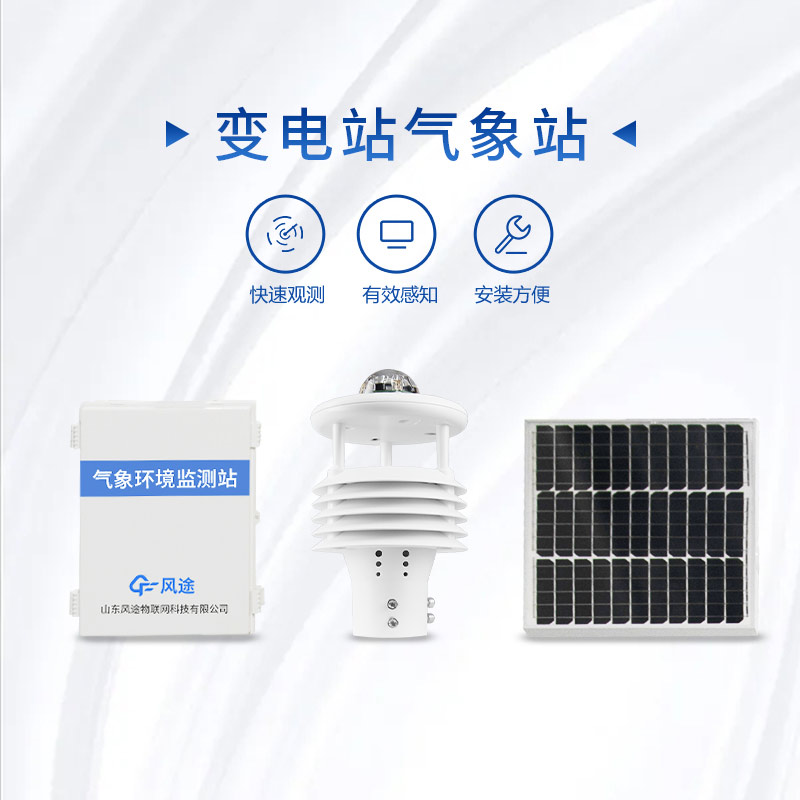Tianqiong Sensor IOT Technology Co., Ltd
Sales Manager:Ms. Emily Wang
Cel,Whatsapp,Wechat:+86 15898932201
Email:info@fengtutec.com
Add:No. 155 Optoelectronic Industry Accelerator, Gaoxin District, Weifang, Shandong, China

Sales Manager:Ms. Emily Wang
Cel,Whatsapp,Wechat:+86 15898932201
Email:info@fengtutec.com
Add:No. 155 Optoelectronic Industry Accelerator, Gaoxin District, Weifang, Shandong, China
time:2025-04-07 09:57:49 source:Weather Station viewed:3 time
Meteorology encompasses a wide range of elements, such as rain, ice, wind, frost, clouds, and temperature, among others. In the power system, "micro-meteorology" is different from what is described in meteorology. Power micro-meteorology refers to the meteorological conditions in a small section of the transmission line. This section of the line may be only tens to hundreds of kilometers long, or it may even refer to a small area around one or two transmission towers. Due to the influence of the terrain, meteorological factors such as ice conditions and wind force in these areas are more severe than those in the entire line area, and it is very likely to pose a threat to the safety of the transmission line.
The scope of power micro-meteorology can be large or small. For transmission lines, it can refer to the area within 100 meters, 200 meters, or 1000 meters around a transmission tower, or it can refer to the section of the line between several transmission towers. Micro-meteorology has a particularly significant impact on the safety of transmission lines. According to its causes and the resulting hazards, it can be mainly classified into the following categories based on icing and wind force:
Saddle Pass Type: Among the mountains, there are some saddle passes where the wind will accelerate. If the transmission line is exactly on the saddle pass or crosses over it, the wind speed will increase, and the icing of the wires will be more severe. In severe cases, the transmission towers may even be blown down.
High Mountain Divide Type: When the transmission line crosses the divide of a mountain range, due to the open terrain, it is particularly prone to strong winds, and the icing of the wires will also be very severe. Especially on the mountain top and the windward slope, the wind carrying supercooled water droplets rises along the slope. As the number of water droplets increases, the ice on the wires becomes thicker.
Water Vapor Augmentation Type: If the transmission line is very close to a large lake or a big river, there will be a lot of water vapor in the air. Once a cold wave arrives and the temperature drops below zero degrees Celsius, because of the high air humidity, the wires are particularly likely to form a thick layer of ice.
Terrain Uplift Type: In plains or hills, there are some prominent peaks, as well as mesas and steep cliffs with one side higher and the other side lower in the basin. There is a lot of water vapor in the basin, and the wet and cold air will move up along the slope, forming clouds and mist on the mountain top or the mesa. In winter, when a cold wave comes, a serious icing phenomenon will occur.
Gorge Wind Tunnel Type: When the transmission line crosses over a gorge, the two sides of the gorge are high and steep, acting like a wind tunnel, which will make the wind speed much greater, and the wind force that the transmission line bears will also increase significantly.
The impact of micro-meteorology on transmission lines is both direct and frequent. Accidents such as lightning strikes, icing and snow accumulation on the lines, pollution flashover, and wind deflection are all related to micro-meteorology. Transmission line accidents caused by adverse meteorological conditions occur frequently. However, installing the micro-meteorological monitoring stations of our company can effectively prevent various hazards that micro-meteorology brings to the power system.
The Weather Station for Transformer Substation is a part of the transmission line monitoring system. It generates electricity through solar panels and, via a wireless network, transmits meteorological data such as humidity, temperature, wind direction, wind speed, atmospheric pressure, rainfall, and illumination to the system host in real time. The system will display these data to the staff in the form of reports, statistical charts, curves, etc., and remind them to pay attention to the alarm information and take preventive measures in a timely manner. This can help the staff quickly understand the meteorological conditions in the local area. In case of extremely severe weather, based on the data provided by the monitoring device, preparations can be made in advance to prevent the damage to the transmission line caused by rain, snow, and freezing weather.

The microclimate of farmland refers to the small-scale climatic environment formed by the interaction among the surface air layer, soil layer and crop population in the farmland. It is reflected by the values of agricultural meteorological elements such as radiation, air temperature and humidity, wi...
The petrochemical production process involves a large number of flammable and explosive chemical substances, such as crude oil, gasoline, ethylene, and so on. During storage, transportation, and production, these substances can easily trigger explosions and fires once they encounter an ignition sour...
In contemporary society, air quality is intricately intertwined with our daily lives. Air pollution not only takes a toll on our physical well-being but also exerts adverse effects on the ecological environment and economic development. Globally, air pollution has given rise to a surge in respirator...
In the context of the increasingly accelerating urbanization process today, air quality has become one of the key elements for measuring the quality of life. However, due to the high construction and operation costs and fixed layout, traditional large-scale environmental monitoring stations find it...